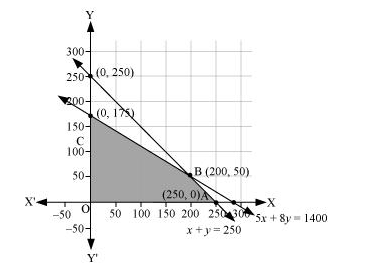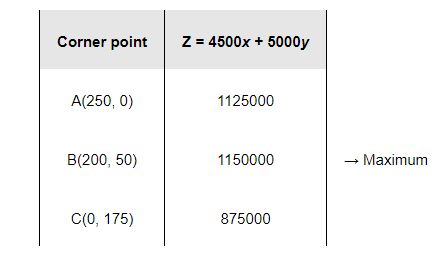A merchant plans to sell two types of personal computers − a desktop model and a portable model that will cost Rs 25000 and Rs 40000 respectively.
A merchant plans to sell two types of personal computers − a desktop model and a portable model that will cost Rs 25000 and Rs 40000 respectively. He estimates that the total monthly demand of computers will not exceed 250 units. Determine the number of units of each type of computers which the merchant should stock to get maximum profit if he does not want to invest more than Rs 70 lakhs and if his profit on the desktop model is Rs 4500 and on portable model is Rs 5000.
Let the merchant stock x desktop models and y portable models. Therefore,
x ≥ 0 and y ≥ 0
The cost of a desktop model is Rs 25000 and of a portable model is Rs 4000. However, the merchant can invest a maximum of Rs 70 lakhs.
$\therefore 25000 x+40000 y \leq 7000000$
$5 x+8 y \leq 1400$
The monthly demand of computers will not exceed 250 units.
$\therefore x+y \leq 250$
The profit on a desktop model is Rs 4500 and the profit on a portable model is Rs 5000.
Total profit, Z = 4500x + 5000y
Thus, the mathematical formulation of the given problem is
Maximum $Z=4500 x+5000 y$ ...(1)
subject to the constraints,
$5 x+8 y \leq 1400$ ...(2)
$x+y \leq 250$ ...(3)
$x, y \geq 0$ ...(4)
The feasible region determined by the system of constraints is as follows.

The corner points are A (250, 0), B (200, 50), and C (0, 175).
The values of Z at these corner points are as follows.

The maximum value of Z is 1150000 at (200, 50).
Thus, the merchant should stock 200 desktop models and 50 portable models to get the maximum profit of Rs 1150000.
